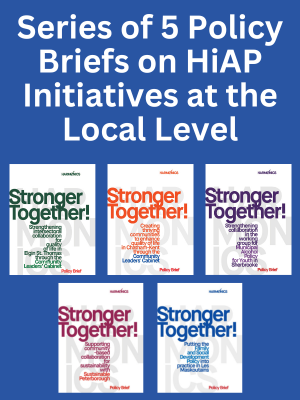Publications

Report of the Canadian Network for Health in All Policies Inaugural Meeting
This report provides an overview and a summary of the main discussions that took place during the inaugural meeting of the Canadian Network for Health in All Policies (CNHiAP), held on September 19 and 20, 2023, in Montréal.

A Call for Your Stories – Do you have any examples of public policy borrowing?
Do you have any examples to share of adopted public policies that were inspired by a public policy implemented in a jurisdiction other than your own? Were you involved in any way in the policy adoption process? Would you like to share your experience? Click to learn more on how you can share your story with us!

Profiles of Public Health Systems in Canadian Provinces and Territories
The NCCHPP is publishing a series of profiles detailing public health systems in Canadian provinces and territories.

Stronger Together! Five Policy Briefs about Strengthening Implementation of Health in All Policies (HiAP) at the Local Level in Ontario and Québec
The HARMONICS research team has partnered with the NCCHPP to produce five policy briefs that feature a series of recommendations for implementing Health in All Policies at the local level.

Poster – Public Health Surveillance Functions in International Jurisdictions
This poster presents an overview of an international environmental scan aimed at describing characteristics of national public health surveillance functions from countries with contexts comparable to Canada. This study equips public health professionals with insights to better identify and understand the dynamics of public health surveillance systems across international contexts, akin to Canada’s. It sheds light on the imperative of infectious disease surveillance, especially highlighted by the COVID-19 pandemic, while also pointing towards future challenges and opportunities such as real-time data utilization, digitalization, and enhanced knowledge sharing. Through this, it supports efforts to refine surveillance strategies, innovate with data integration, and foster informed decision-making for improved public health outcomes.

International environmental scan of public health surveillance functions
This environmental scan aims to describe characteristics of national public health surveillance functions from countries with comparable contexts to Canada to provide a global perspective on corporate surveillance system coordination functions at a national level.

What Factors Can Public Health Actors Consider to Facilitate the Borrowing of a Public Policy?
This document presents a list of factors that public health actors can mobilize when considering proposing the adoption in their jurisdiction of public policies that have been effective elsewhere.

Supporting Public Health Human Resource Planning: A Survey of Canadian Universities’ Public Health Training Programs
This document provides a snapshot of Canadian university public health education program offerings in 2022 and is intended to inform ongoing discussions related to public health workforce planning and capacity building in Canada.

Intersectoral Action for Health and Equity in the Context of Budget Cuts
The purpose of this document is to inform Canadian public health professionals and administrators, as well as any other actors interested in undertaking and sustaining intersectoral action for health and equity in the context of budget cuts. It introduces the challenges ahead, the opportunities to be seized, and the strategies to be considered.

Developing a Canadian Network for Health in All Policies: Consultations with Actors from Canada and Abroad
This report presents the results of a consultation to guide the development of a Canadian Network for Health in All Policies.


